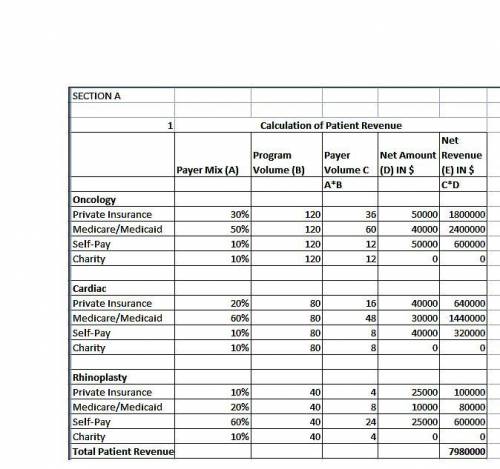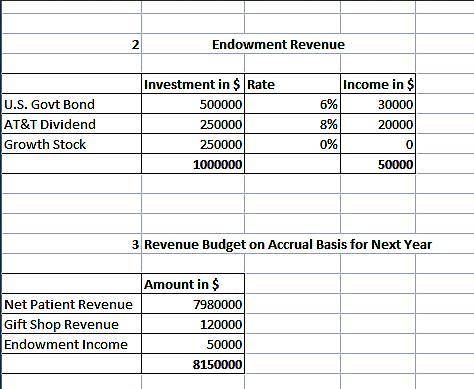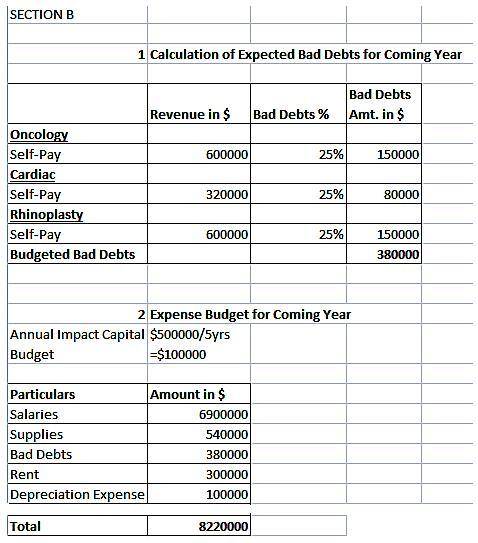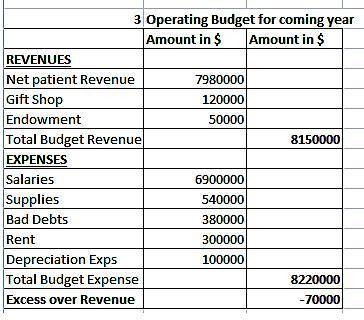
Business, 21.06.2021 16:00 cricecrice7256
Denison Specialty Hospital is planning its master budget for the coming year. The budget wil include operating, capital, cash and flexible budgets. The hospital is noted for its three fine programs: oncology (cancer), cardiac (heart), and rhinoplasty (nose jobs).
Section A
The managers at Denison have been busy working. They have reviewed past records and considered changes in competition, the general economy, and overall medical trends. Using past charges and anticipated rates of medical inflation, they have also made a first attempt at setting thier prices.
Based on a thorough review and discussion of these data, they have projected that next year they will have 240 patients. They expect 120 oncology patients, 80 caridace patients, and 40 rhinoplasty patients.
The charge, of list price, for oncology patient will average $50,000. Cardiac patients will be charged on average of $40,000, and rhinoplasty, $25,000 per patient. However, those charges are not the actual amounts ultimately received.
The amount the hospital receives depends on whether patients pay their own hospital bills or have healthcare insurance. Assume that private insurance companies pay the full charge or list price. However, Medicare and Medicaid have announced rates they will pay for the coming year as follow: oncology patients $40,000, cardiac patients $30,000, and rhinoplasty patients $10,000. Self-pay patients are supposed to pay the full charge, but generally 25 percent of self-pay charges become a bad credit. Note that bad credit are treated as an expense in healthcare. They may not be shown as a reduction lowering revenues. The full charge for self-pay patients is shown as revenues, and then the uncollectible amount is shown as an expense. No payment for charity care is ever recieved, and charity care is not shown s a revenue or expense.
The payer mix is as follows:
Private insurance Medicare/Medicaid Self-Pay Charity
Oncology 30% 50% 10% 10%
Cardiac 20% 60% 10% 10%
Rhinoplasty 10% 20% 60% 10%
Gift shop revenue is projected to be $120,000 for the current year and is expected to remain the same. However, this revenue will increase or decline in proportion to charges in patient volume.
Denison Hospital has an endowment of $1,000,000. It is invested as follows:
a-$500,000 in 6 percent U. S. Governement Bonds that pay interest annually
b-$250,000 in AT&T stock, which pays a dividend of 8 percent annually
c-$250,000 in growth stocks that pay no dividend
Section A requirements:
1. Calculate patient revenue on an accural basis for the coming year. Subdivide revenue by program, and with each program subdivide it by type of payer.
2. Calculate endowment revenue on an accural basis for the coming year.
3. Prepare a revenue budget on an accural basis, including all sources of revenue discussed previously. The revenue budget does not have to show all of the detail from requirements 1 and 2, but should show each major source of revenue, such as patient services and endowment.
Section B
The hospital expects to employ worker in the following departments
Radiology Nursing Administration Total
Managers 100,000 200,000 200,000 500,000
Staff 1,900,000 4,200,000 300,000 6,400,000
Total 2,000,000 4,400,000 500,000 6,900,000
Supplies are expected to be purchased throughout the year for the departments, as follows:
Total
Radiology 360,000
Nursing 160,000
Administration 20,000
Total 540,000
Assume that all supply use varies with the number of patients.
Denison Hospital currently pays rent on its building and equipment for $300,000 per year. Rent is expected to be unchanged next year. The rent is paid $75,000 each quarter.
To better serve its patients, Denison would like to buy $500,000 of new oncology equipment at the start of the year. It would be paid for immediately upon purchase. The equipment has a 5-year life and would be expected to be used up evenly over that lifetime. Although the capital budget would normally include justification for why the equipment is needed, it is sufficient for our purpose to know that the capital budget for Denison is $500,000 and the equipment to be purchased has 5-year useful life. It will have no value left at the end of the 5 years. Denison charges the cost of its capital acquisitions on a straight-line depreciation basis. The means that the cost is spread out over the useful life, with an equal being charged as an expense, called depreciation expense, each year.
Section B Requirements:
1. Calculate expected bad debt expenses on an accural basis for the coming year
2. Calculate an expense budget on a accural basis for the coming year. The expense budget does not require detailed information by program or department, but should show each type of expense as salaries and supplies. Be sure to consider the impact of capital acquisitions on the expense budget.
3. Combine the revenue (section A) and expense budget to present an operating budget for the coming year.

Answers: 2


Another question on Business

Business, 22.06.2019 00:50
cranium, inc., purchases term papers from an overseas supplier under a continuous review system. the average demand for a popular mode is 300 units a day with a standard deviation of 30 units a day. it costs $60 to process each order and there is a five−day lead−time. the holding cost for a paper is $0.25 per year and the company policy is to maintain a 98% service level. cranium operates 200 days per year.what is the reorder point r to satisfy a 98% cycleminus−service level? a. greater than 1,700 unitsb. greater than 1,600 units but less than or equal to 1,700 unitsc. greater than 1,500 units but less than or equal to 1,600 unitsd. less than or equal to 1,500 units
Answers: 1

Business, 22.06.2019 11:20
Aborrower takes out a 30-year adjustable rate mortgage loan for $200,000 with monthly payments. the first two years of the loan have a "teaser" rate of 4%, after that, the rate can reset with a 5% annual payment cap. on the reset date, the composite rate is 6%. what would the year 3 monthly payment be?
Answers: 3

Business, 22.06.2019 17:40
Within the relevant range, if there is a change in the level of the cost driver, then a. total fixed costs will remain the same and total variable costs will change b. total fixed costs will change and total variable costs will remain the same c. total fixed costs and total variable costs will change d. total fixed costs and total variable costs will remain the same
Answers: 3

Business, 22.06.2019 19:30
Which of the following statements are false regarding activity-based costing? non-manufacturing costs are important to include when calculating the cost of each product. costs are allocated based on a pre-determined overhead rate. transitioning from traditional costing methods to activity-based costing can be complicated and costly. activity-based costing follows the same basic calculation methods as traditional costing approaches. none of the above
Answers: 2
You know the right answer?
Denison Specialty Hospital is planning its master budget for the coming year. The budget wil include...
Questions

Advanced Placement (AP), 25.09.2021 23:20





Mathematics, 25.09.2021 23:30

SAT, 25.09.2021 23:30



Mathematics, 25.09.2021 23:30



Mathematics, 25.09.2021 23:30

Biology, 25.09.2021 23:30

History, 25.09.2021 23:30



Chemistry, 25.09.2021 23:30

Mathematics, 25.09.2021 23:30







